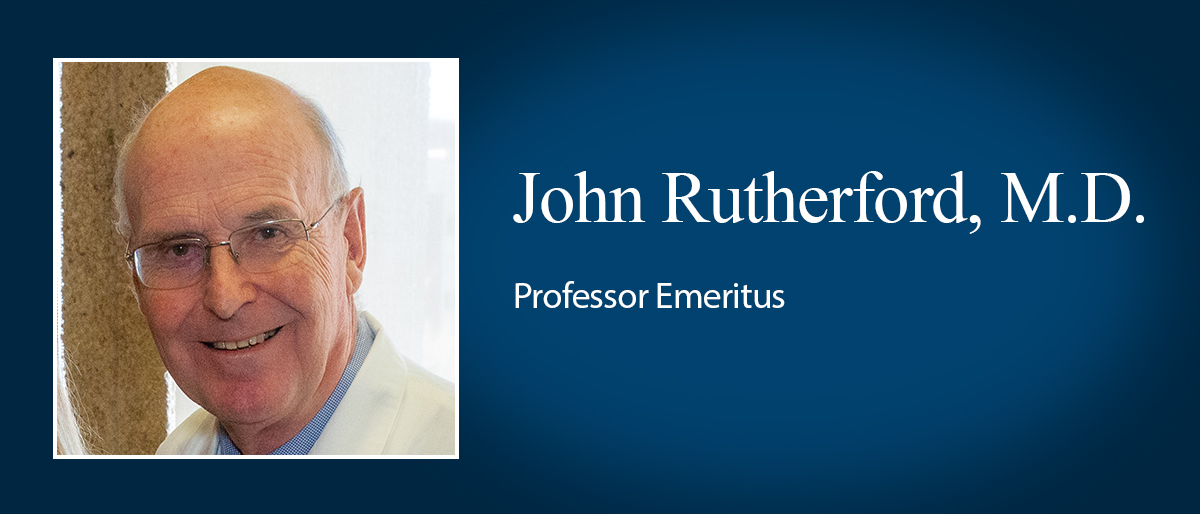Longtime Clinical Operations VP Rutherford appointed Professor Emeritus

When John Rutherford, M.D., got the call from UT Southwestern in 1993 inviting him to revamp its then-fledgling Department of Cardiology, he was working at Brigham and Women’s Hospital in Boston. He liked what he was doing. His career had begun at Harvard Medical School, where he had gone after receiving a traveling research fellowship from the National Heart Foundation of New Zealand, his home country.
But how could he turn down this offer from Texas, at an institution that was, he said, “very famous for science”?
“It provided challenges and opportunities in cardiovascular medicine, and I took it,” Dr. Rutherford said. “We got some momentum going, and we achieved a lot. It was a big challenge, and I wanted to see it through.”
Thirty-two years, hundreds of patients, and countless accomplishments, conundrums, collaborations, revamping, and research projects later, Dr. Rutherford retired as Vice President of Clinical Operations and Professor of Internal Medicine earlier this year and was appointed Professor Emeritus.
“I’m proud that, along with my colleagues and the support of the administration, we’ve had the ability to cooperate, to build and grow, and to have a little bit of fun along the way,” Dr. Rutherford said.
It didn’t take long for him to make an impact. Just two years after his arrival, Dr. Rutherford received the Distinguished Physician Award in recognition of outstanding contributions to Parkland Memorial Hospital.
That was only the beginning of his accolades and appointments: Associate Dean for Clinical Affairs, 1997; President of the Medical Staff at Parkland Health and Hospital System from 1998 to 2000; Vice President for Clinical Operations, 2001; and holder of the Jonsson-Rogers Chair in Cardiology, 2005.
Additionally, he played key roles in implementing Epic, an electronic health medical record system – which had been nonexistent at UT Southwestern before his arrival – and the Press Ganey platform, which collects patient experiences and other analytical health care data.
“We previously had no such feedback,” said Associate Vice President Craig Glazer, M.D., M.S.P.H., M.S.-M.A.S., FCCP, who credits Dr. Rutherford with encouraging him to apply for Chief Medical Officer, University Hospital, the position he now holds.
“The whole idea of this wasn’t initially popular with providers, but his answer was, ‘How could you not want to know what patients think?’ Through him, we made a promise to do more than provide medical care,” said Dr. Glazer, also Professor of Internal Medicine. “He wanted patients to feel cared for.”
Interestingly, when Dr. Rutherford arrived at UT Southwestern, the culture “was basically to do research, teach, and see patients at Parkland,” he said. “It was a bit of a dramatic shift to see increasing numbers of private patients as well.”
That shift began in 2000, he said, when UT Southwestern acquired St. Paul Hospital. In 2025, the Medical Center was certified as a Comprehensive Cardiac Center by The Joint Commission and ranked in the top 25 heart and vascular hospitals by U.S. News and World Report.
As the Cardiology Department advanced, Dr. Rutherford made sure to keep patient needs in focus. Dr. Glazer described him as “our biggest champion for the patients.” Yet, he added, Dr. Rutherford never considered himself a saint, rescuing people and saving lives – the way some regarded doctors.
“By telling people that doctors can’t do it alone, he was a trailblazer,” Dr. Glazer said. “Medical care has become so complex. It’s delivered through a team approach, and Dr. Rutherford made sure everyone knew that. He was humble, and if he screwed up, he’d own it.”
Dr. Rutherford wore more leadership hats than most people have fingers. But everything he did came back to the patients, particularly those with acute myocardial infarction, heart disease in pregnancy, chronic coronary artery disease, and general cardiology diseases.
Through the years, lifestyle choices have increased the incidence of heart disease and other chronic illnesses. Instead of directly telling his patients what they needed to do, Dr. Rutherford would instead ask: “Where would you like to start?”
“It’s evolved to shared decision-making,” he said. “What are their needs? What do they want? What can I do to help them meet their goals?”
As he approaches age 80, Dr. Rutherford takes care of his own health by walking, playing golf, and working out weekly with a personal trainer. He and his wife, Cynthia, a hematologist, have two children: Anna is a transplant hepatologist at the Boston hospitals where Dr. Rutherford began his career; Matt holds a doctorate in computer science and is an Associate Professor at the University of Denver.
Since Dr. Rutherford stepped down from official duties last spring, “it feels like a vacuum not having him here,” Dr. Glazer said. “But if issues come up in meetings we used to have together, I think, ‘What would Dr. Rutherford do here?’ It’s a stress test in my head.”
For his part, Dr. Rutherford loved his work, but knew the time had come to leave.
“I’ve enjoyed being engaged with the challenges, the problem-solving, and the people,” said Dr. Rutherford, who is writing a book about the history of cardiology at UT Southwestern. “We have a tremendous team in place – mid- to late-career people. They’re innovative and smart. They go with the flow and improve things even more.”

